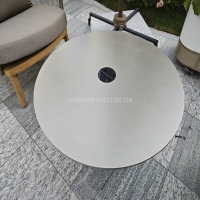Welcome to the website for landscape facilities products and knowledge.
How does the table’s design facilitate easy integration with outdoor language or cultural exchange programs?
In the realm of outdoor education and cultural immersion, the humble table transforms into a powerful tool for fostering international dialogue and understanding. Modern outdoor table designs specifically address the unique requirements of language and cultural exchange programs through several innovative features that conventional furniture overlooks.
The circular or oval configurations of these tables represent a fundamental shift from traditional rectangular designs. This intentional geometry eliminates positional hierarchy, allowing all participants equal visual access and engagement opportunities. Unlike linear arrangements where end seats create psychological barriers, circular setups promote inclusive participation where every participant feels equally valued and heard. The absence of "head" positions encourages spontaneous interactions and prevents the formation of subconscious cliques based on language proficiency or cultural background.
Integrated seating represents another crucial design element. Benches permanently attached to the table structure serve multiple purposes beyond mere convenience. They create a cohesive unit that discourages participants from physically distancing themselves from the group, maintaining circle integrity throughout activities. The fixed seating arrangement also subconsciously communicates that all participants are united in the learning experience, despite varying language capabilities or cultural perspectives. This physical connectedness often translates into improved psychological openness during conversation exercises.
Surface functionality plays an equally important role in facilitating cultural exchange. Many specialized tables incorporate dry-erase surfaces or built-in board game patterns directly into the tabletop. These features transform the table from passive furniture into an active learning instrument. Participants can spontaneously diagram vocabulary, play language games, or illustrate cultural concepts without additional equipment. The integration of these elements removes barriers to impromptu teaching moments that often yield the most genuine cultural exchanges.
The materials and construction further enhance the table's suitability for outdoor programs. Weather-resistant composites and treated woods ensure durability across seasons while requiring minimal maintenance. This practicality means program coordinators can leave tables installed in optimal outdoor settings—whether in garden corners, beneath shade trees, or overlooking scenic vistas—without constant transportation concerns. The permanent yet discreet installation creates dedicated spaces that participants begin associating with language practice and cultural sharing.
Portability considerations address the flexible nature of outdoor programs. Lightweight yet stable designs allow for easy rearrangement to accommodate varying group sizes or activity types. Some models feature folding mechanisms or modular components that enable quick configuration changes from large group discussions to intimate partner exercises. This adaptability ensures the environment can evolve with program needs throughout the day without interrupting the flow of cultural exchange.
Perhaps most importantly, these designs acknowledge the psychological impact of environment on language acquisition and cultural sharing. The use of natural wood tones, organic curves, and earth-friendly materials creates an inviting atmosphere that reduces the anxiety often associated with speaking foreign languages. Unlike formal classroom settings that can trigger performance pressure, these outdoor tables establish a casual, retreat-like environment where mistakes become part of the learning journey rather than sources of embarrassment.
The combination of these design elements—non-hierarchical shapes, integrated community seating, interactive surfaces, durable materials, flexible configurations, and psychologically supportive aesthetics—creates an optimal environment for breaking down cultural and linguistic barriers. When participants gather around these thoughtfully designed tables, the furniture itself becomes an invisible facilitator of connection, encouraging the shared vulnerability and mutual discovery that define meaningful cross-cultural exchange.
Related search:

Recommendation
Outdoor stainless steel table with solar-powered ambient lighting feature - excellent design.